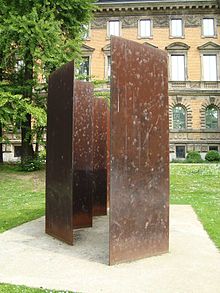Tzimtzum

Tzimtzum , often Tzimtzum ( Heb. צמצום , literally, concentration 'or' contraction ') is, according to the Kabbalah in the tradition of Isaac Luria's self-contraction of God from his own center. A mystical cavity is created through which the existence of the universe is made possible in the first place. The Zohar did not yet know the concept of tzimtzum. The teaching originated in the second half of the 16th century in the Galilean city of Safed and was written down and disseminated in different versions by the students of Luria. The plural tzimtzumim denotes the one who conquers his desires. Who withholds himself and does not receive, although he longs very much to receive.
contraction
His power as creator lies precisely in the limitation of God. In the beginning everything was filled with the simple light of En Sof . This contracted in the middle of its light. This created an absolutely uniform empty space, a spherical ball in the middle of infinity. Without the tzimtzum there would have been no room for creation. According to the Maggid Devaraw, God is present in the world as a limitation, that is, as Tzimtzum. It is through this limitation that he created the world. At the same time, this self-limitation is the wisdom of God. With the Tzimtzum, the En Sof has restricted itself in the middle of its light to leave an empty cavity. this happened
"[...] to create the aspect of the vessels. Because through a tzimtzum of light and its diminution, the possibility for the emergence and revelation of the vessel was created. Because when the light gets out of hand, the vessel is dissolved because of its little power to receive the strong and great light. So first a tzimtzum and a diminution of the light are required, and through this the existence of the vessel is revealed. "
The infinite light contracts to create an empty space which is encircled by the vessels ( kəlīm ) of the ten Sephiroth and which are gradually permeated by the infinite light. However, since the inner six vessels cannot withstand the violence of the infinite light, they break ( Schwirat ha-Kelim ), but remain in the world as "shards" ( qlīpōt ) and cause of evil . In a second act of creation, five “figures” ( parṣūfīm ) are created as receptacles for the Sefirot in this empty space.
Nothing and wisdom
In addition, the Tzimtzum is sometimes interpreted as the creative nothing of divine unity. The nothing is the wisdom and the wisdom is the Tzimtzum. God created the world from the Tzimtzum or nothing. This nothing is therefore not the opposite of being . Rather, it is the deity present in the tzimtzum. So this nothing is the life force of the world every day. Tzimtzum on the divine side corresponds to letting go of the material world on the human side . The deity descends into nothingness and man ascends in an act of becoming one to the divine wisdom ( Ḥochmā ) of nothingness in the sense of a unio mystica . The goal is the contemplative dismissal of the material and human self-consciousness .
Others
A cosmological alternative model ( Big Bounce ) is also based on an initially infinite and completely uniform universe that condenses in a contraction that is assumed to be spontaneous, down to an extremely small, almost punctiform space ( Planck scale ). When the energy density reached a certain threshold, the contraction stopped and, in this model, led to the expansion ( "big bang" ), which the present-day universe with its mass, created through a quantum-physically based kind of rebound effect ( bounce ) .
In contemporary painting , Anselm Kiefer, with his work Zim Zum from 1990, most clearly uses the original tradition of retreat.
The American color field painter Barnett Newman titled one of his rare sculptures ZIM ZUM II. The folded walls made of Cor-Ten steel create a walk-in open space. Newman designed a synagogue in 1963 , which ZIM ZUM represents as an empty place from which God has withdrawn.
The pop singer Madonna refers to the Lurian Kabbalah and the Zim Zum.
Quote
"Zim-Zum [...] the dear Lord pulled in the stomach, and there was room!"
literature
- Karl Erich Grözinger : Jewish thinking. Theology - Philosophy - Mysticism . Volume 2: From Medieval Kabbalah to Hasidism . Campus-Verlag, Frankfurt am Main et al. 2004, ISBN 3-593-37513-3 .
- Gershom Scholem : Jewish mysticism in its main currents . Metzner, Frankfurt am Main 1957, (new edition: Suhrkamp, Frankfurt am Main 2000, ISBN 3-518-27930-0 ).
- Gerschom Scholem: Creation out of nothing and God's self-entanglement , in: Scholem, On some basic concepts of Judaism, Frankfurt / M. 1970.
- Christoph Schulte : Zimzum: God and world origin . Berlin: Jüdischer Verlag, 2014, ISBN 978-3-633-54263-5 .
Individual evidence
- ↑ Scholem: The Jewish mysticism in their main currents , p. 285.
- ↑ BNEI BARUCH: STUDYING KABBALA. Glossary, January 1, 2017, accessed July 7, 2017 .
- ↑ Maggid Devaraw § 1, p. 9; see. Groezinger p. 813.
- ↑ Ez ha-Hajjim, Sha'ar I, Anaf III, Jerusalem 2003, p. 10; Groezinger, p. 813.
- ↑ Grözinger, p. 818.
- ↑ Grözinger, p. 849.
- ↑ Angelika Storm-Rusche: The American Barnett Newman in the art collection of North Rhine-Westphalia Düsseldorf. Berliner Zeitung, May 23, 1997, accessed on March 17, 2017 .
- ↑ Prof. Christoph Schulte: On the trail of a Kabbalistic teaching in Jewish and Christian intellectual history since 1570. Egalitarian Minyan, February 7, 2015, accessed on July 7, 2017 .
- ↑ Niewiadomski Jozef: "Zim-Zum", or the logic of taking back oneself. University of Innsbruck, December 15, 2012, accessed on July 7, 2017 .
